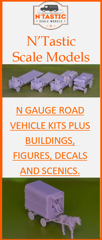- Welcome to N Gauge Forum.
Recent posts #11
N Gauge Discussion / Re: NGF Wagon/Van 2025 - Ideas...Last post by Bealman - Yesterday at 11:11:50 PMAs has already been pointed out, the only options available are at the top of the thread.
#12
N Gauge Discussion / Re: NGF Wagon/Van 2025 - Ideas...Last post by earlofsodbury - Yesterday at 11:04:52 PMQuote from: madchadbrad on Yesterday at 10:43:11 PMWhat about a Siphon G or H ? ... In the perhaps unlikely event this is possible, I'm actually looking out for a couple I can use in an era 5-6 contex  t t #13
N Gauge Discussion / Re: NGF Wagon/Van 2025 - Ideas...Last post by madchadbrad - Yesterday at 10:43:11 PMWhat about a Siphon G or H ?
I know they used to be available unpainted from Dapol. They could be realistically liveried to appeal to modellers of non passenger rollingstock as well as goods vehicles. I'm sure someone could come up with an authentic and believable scheme ... #14
General Discussion / Re: Royal Train Loco InsigniaLast post by njee20 - Yesterday at 10:40:13 PM67s are being scrapped as they have no revenue earning work. Whilst anything with a Royal insignia will always be popular there's a good chance these won't see any more front line action and will quite likely rot at Toton before being chopped up!
The most obvious candidate would be Shawplan - they do a set for the existing loco(s). The frustration is how hard it is to get hold of Brian to actually order anything, let alone make an enquiry about whether he'll be updating his etches! #15
General Discussion / Re: what are you listening to ...Last post by Newportnobby - Yesterday at 10:05:05 PMSaw them at the De Montfort Hall, Leicester in the 70s and was blown away
#16
General Discussion / Re: Royal Train Loco InsigniaLast post by GlenEglise - Yesterday at 08:37:05 PMQuote from: njee20 on June 30, 2025, 10:36:40 PMNot sure you'll get many people falling over themselves to do new etches! I am not sure why you suggest that. Locomotive nameplates etc. for steam and diesel locos abound and most of them have been scrapped. As the last example of a Royal Train surely that would make it an outstanding candidate for replication of the insignia and nameplates. Just my thoughts. GE #17
General Discussion / Re: what are you listening to ...Last post by Newportnobby - Yesterday at 03:49:43 PMQuote from: Moonglum on Yesterday at 12:21:13 PMOh yeah! I met Sonia K about 10 years ago, she's getting on a bit now. Ain't we all, Tim  #18
N Gauge Discussion / Re: NGF Wagon/Van 2025 - Ideas...Last post by Newportnobby - Yesterday at 03:42:13 PMI like that, especially the '10ft - feels longer'
 #19
General Discussion / Re: what are you listening to ...Last post by port perran - Yesterday at 02:27:56 PMBack Street Luv was one of my favourite singles from the early 70s from a really good LP - Curved Air 11
I saw Curved Air just the once when BSL was in the charts. And although I'm not a huge fan of Guns n Roses I do like November Rain. I saw them, dragged along kicking and shouting by my daughter, with The Cure at Milton Keynes Bowl in the late 90s. #20
General Discussion / Re: what are you listening to ...Last post by kusojiji - Yesterday at 01:31:01 PMIs this from the black felt, black light poster days?
 | Please Support Us!
July Goal:
£100.00 Due Date: Jul 31 Total Receipts: £23.45 Below Goal: £76.55 Site Currency: GBP 23% July Donations |







